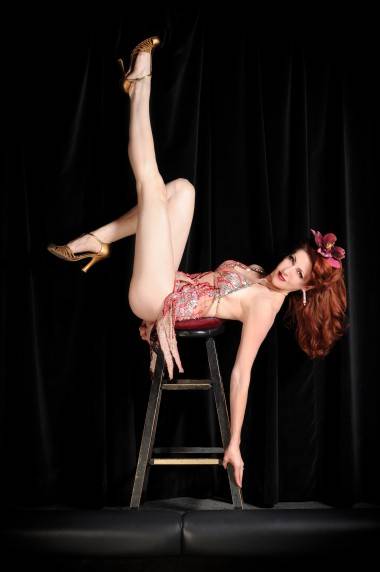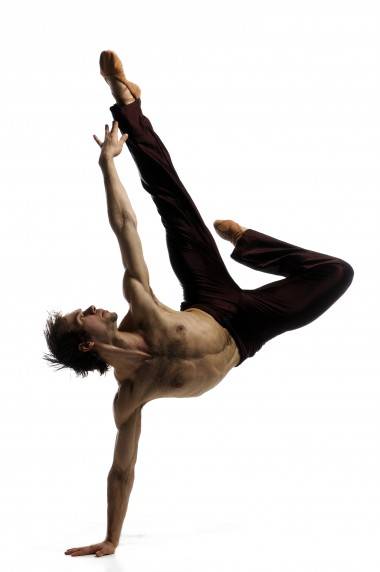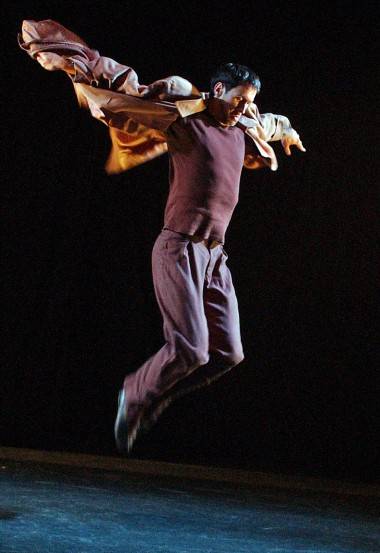Interview – Julie-anne Saroyan, Dances for a Small Stage 24 curator
– by Zoe Grams
In its 24th edition, the lauded series Dances for a Small Stage shines a light on society’s problems and complacency, while providing solace in creativity and humour.
Taking inspiration from the Weimar cabaret of the politically fraught pre-WWII Germany, seven short performances explore the theme of taboo and complacency under duress. These big ideas will take place on a small stage, just 10-by-13 foot in size, at the Legion on Commercial Drive, Aug 10 – 12.
Mixing provocation and beauty can be a difficult task, but Dances for a Small Stage has always been a careful balancing act, combining performers of wildly varying genres to create a cohesive show. On the bill this time are Mark Berube, Jim Hibbard, Edmond Kilpatrick, Caroline Liffman, Lina Fitzner, Shannon Moreno, Burgundy Brixx and Now or Never, performing pieces ranging from dance-theatre to contemporary, tap to hip hop to burlesque.
We spoke to Dances for a Small Stage 24 curator, and MovEnt Artistic Producer, Julie-anne Saroyan, about the show’s ambitious purpose, and got a behind-the-scenes peek at what to expect from some pieces.
Zoe Grams: This is just the second time you’ve chosen a theme for the performances. Why did you decide to continue using themes, and what made you choose this one?
Julie-anne Saroyan: It was partly based on the success of the last show. I feel like audiences like that direction but that the artists also like these task-orientated things. It’s really something the artists take as a challenge and really reinterpret.
For this show in particular, I started being fascinated by cabaret about a year ago. I was fascinated by how artists used the platform to make social commentary, so I was hoping the artists would do something similar and really run with it. Burgundy Brixx and Edmond Kilpatrick really rose to the challenge.
ZG: In describing the show, you mentioned challenging times when “great thinkers are noxiously ambushed on live TV.” Was the theme, and this statement, a direct response to Krista Erickson’s incendiary interview with Margie Gillis?
Watch – Sun News’ Krista Erickson’s interview with Margie Gillis (pt. I):
http://youtu.be/LrUfKrQpQbg
JS: That’s an interesting question. I got on the cabaret tangent and then this happened with Margie. That was the epitome of criticism, the epitome of “Are you kidding me?” A highly respected artist in the community criticized by some little girl. I mean, it’s easy to justify why afterwards, but this all came together exactly the way I envisioned. The artist’s job is to comment on society; it’s a privilege to be able to do that.
ZG: One artist in Dances for a Small Stage 23 asked whether they could use live pigeons in the Legion. Are there any surprises in this show?
JS: Yes! One of the pieces, actually – by Burgundy Brixx – is taking an incredible, brave risk. She’s doing two pieces, and one of them is straight-up burlesque. The second piece is about the Picton women… I find it extremely powerful. She’s doing a work that steps outside of her comfort zone as a burlesque artist. Now there’s a level of politics in this show that I wasn’t anticipating.
ZG: Tell us about the hip hop troop in this edition.
JS: We’ve done hip hop a few times. In Janet Smith’s review in the Georgia Straight for Dances 23, she kind of asked, “What is dance anyway? What is the development of dance?” I feel this show is the development of dance. This is the show that has hip hop, and ballerinas, and a burlesque artist. At rehearsal today, all these people were commenting on each other’s work, and that’s really exciting to me. It’s generational.
ZG: In all Dances for a Small Stage, there are different genres, different performers, different styles, yet overall it feels like one very cohesive piece. What do you do to achieve this?
JS: I have a level of trust with each of the artists. I work on a lot of instinct and I think about my dad – how my dad watches things. He’s a retired machinist; he’s not an artist. I feel like I’m creating work for people, and I focus on that while I’m watching a piece and also asking questions of the artist. I’m defining an entry point for the audience.
The program order is also extremely important – the ebbs and flows of the evening. It can really kill a show, not thinking about that or leaving it to chance. There’s certainly no formula to it – how you want to start a show, where you want to be at intermission, how you want to end the show. It’s my job to make sure the audience travels. The journey of the evening is really important.
ZG: What should people watch for in the show?
JS: I think they should watch out for hidden meanings in the show, and challenge themselves to think outside the box. What is dance, anyway? I want them to walk away with that.
Dances for a Small Stage 24 info:
Dances for a Small Stage 24 – August 10,11 and 12, 2011
The Legion on the Drive, 2205 Commercial Drive
Tickets $20, Cash at the door, 19+ admitted.




